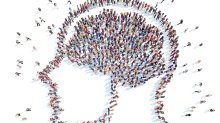Learning and the Social Brain
In a series of interviews, researcher Patricia Kuhl reveals the science behind the social brain—which she calls the gateway to human cognition.
What prompts even the youngest infants, their heads wobbling almost imperceptibly on weak neck muscles, to stare so intently at faces both familiar and unfamiliar? What causes them to reach out without warning and latch on to a nose or an ear with tiny, prehensile fingers? And why, at even a few months old, do they track the eye movements of their parents, and engage in endearing games of facial and verbal mimicry?
“We know we start this way,” said Dr. Patricia Kuhl, the Bezos Family Foundation Endowed Chair at the at the University of Washington, in a series of interviews on the science of human learning. “When you look at the studies on very young human babies, even newborns, they are captivated by the human face. And newborns have the ability to imitate the facial expressions of another person, so they open their mouths when you open your mouth, and they stick out their tongue when you stick out your tongue.”
This preoccupation with the face has its origins in human evolution, according to Kuhl, and is explained by a complex neural network designed to interpret social cues—what neuroscientists call the social brain. Operating throughout our lifetimes, the social brain is responsible for making sense of a bewildering, often ambiguous range of human gestures that are crucial for survival. How we respond to an ominous glint in the eye or a fleeting grimace may seem like child’s play. But differentiating between violent intent and mere irritation is sometimes the difference between life and death—and the games we play when we’re young are critical practice for the more serious business of getting along later in life.
“We’re always trying to understand what the other person’s doing,” explained Kuhl, reflecting on our fundamentally inquisitive, social nature. “In order to survive as a species, we had to learn to ‘read’ the people around us so that we could collaborate, fight enemies, and find food. So the social brain is [always] there, and it appears to be active very early in our development.”
For educators, an awareness of the social brain presents an opportunity to tap into some of our most durable, deeply seated abilities. If the species is hardwired to work together, then our classrooms should continue to feature a healthy dose of activities that emphasize cooperation, teamwork, and peer-to-peer teaching.
Even the simplest tactics should reap dividends, according to Kuhl, who suggests using “circles or U-shaped arrangements”—or anything that gets kids interacting with one another. “The social context is extremely important to learning,” she noted, “not only in infancy, but in school-aged children, who use the social brain when they’re collaborating with one another, when they’re studying how another person goes at it, when they’re watching the eyes, even unconsciously, of their study partner as they work towards a solution together.”
New research indicates that there are some limits to these findings. For autistic children, there is evidence, confirms Kuhl, that “human faces are less interesting and less motivating,” so social learning may be less beneficial—or simply different—for students on the spectrum. And recent scholarship on introversion in the classroom suggests that the disposition is as much an asset as a liability: Introverted children excel in attention to detail, problem solving, and creativity. Children are not one-size-fits-all, and classrooms must adapt to meet the needs of all learners.
But for most children, the implications of the research on the social brain are clear. “There’s something about being in the the presence of another human being” that drives human learning, says Kuhl. “Without the motivation and information provided by the social brain, learning just doesn’t take off in the same way that it does when the social brain is engaged.”
In this four-part video series, we take a closer look at Kuhl’s fascinating insights on the science of human learning, with a focus on the positive—and cautionary—aspects of our social brain.
—Stephen Merrill
�鶹��ý��� developed this series in collaboration with the National Commission on Social, Emotional, and Academic Development, with support from the Robert Wood Johnson Foundation.




